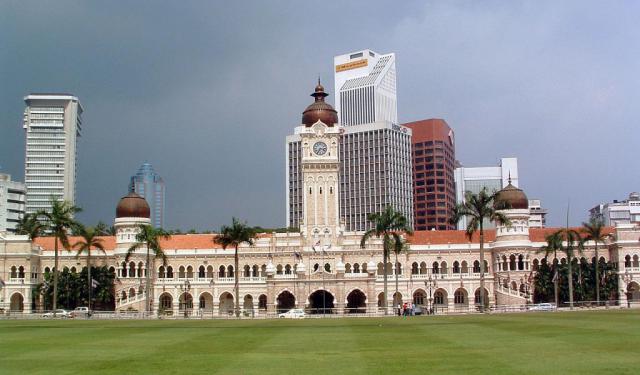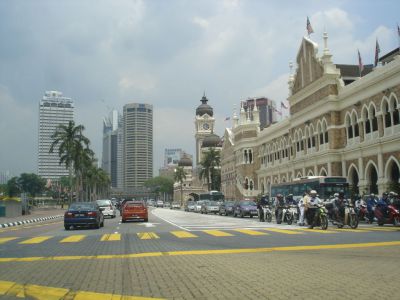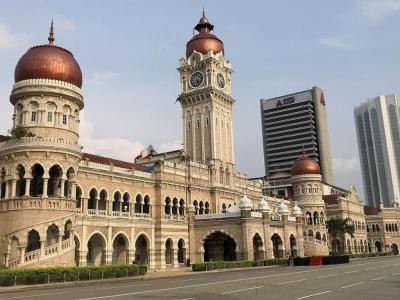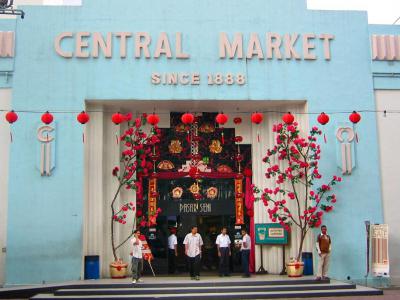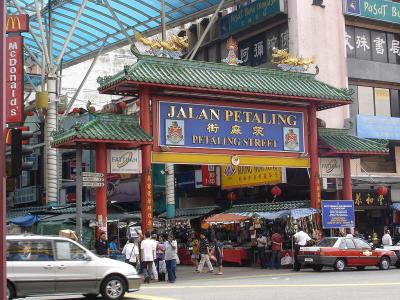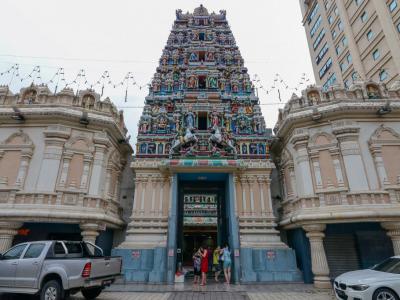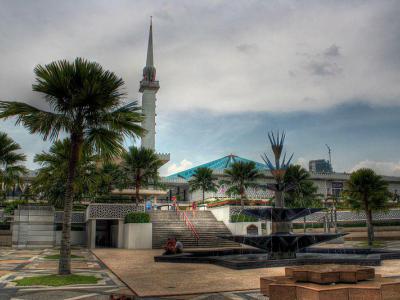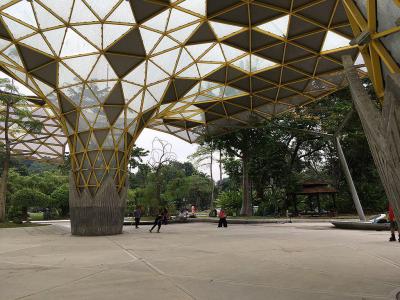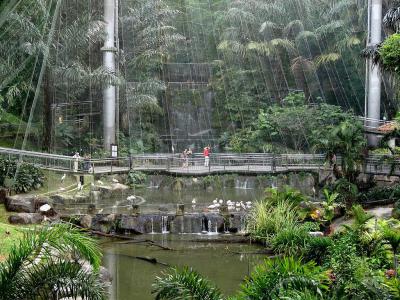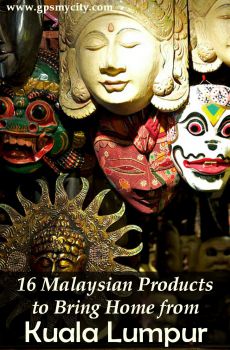Kuala Lumpur Introduction Walking Tour (Self Guided), Kuala Lumpur
Kuala Lumpur, meaning "muddy confluence" in Malay, refers to the city's birthplace at the junction of the Gombak and Klang rivers. Although some Chinese workers were involved in tin mining in the area in the 1840s, it wasn't until 1857 that a town was established here.
Two men in particular have been credited for making outsized contributions to the development of Kuala Lumpur in its early years. Yap Ah Loy, a Chinese businessman and the de facto first mayor of Kuala Lumpur, set up a system of frontier justice which effectively maintained law and order in the town.
Yap Ah Loy also established Kuala Lumpur's first school and a shelter for the homeless. It was under his leadership that Kuala Lumpur became the center of commerce in the Selangor region. Back then, the city center evolved around the present-day Old Market Square.
After Sultan Abdul Samad of Selangor accepted British rule over Kuala Lumpur in 1874, Frank Swettenham became the first British Resident and effectively the mayor of Kuala Lumpur. Swettenham ordered that the city be rebuilt with wider streets and stipulated that its buildings should be constructed of brick and tile so as to become less flammable.
He also initiated the construction of a railway line, which increased accessibility to Kuala Lumpur and spurred the rapid growth of the town. A year after the Federated Malay States were established in 1895, Kuala Lumpur was made their capital.
Some of Kuala Lumpur's most recognizable landmarks emerged in the late 19th - early 20th centuries under the British rule. The local Independence Square was once a cricket field for the British residents. Sultan Abdul Samad Building of 1897, originally known as the Government Offices, was designed for housing the British colonial administration.
Chinese immigrants have played a vital part in the city's development, so it is not at all surprising that Chinatown features prominently in Kuala Lumpur's downtown. Petailing Street is the heart of Chinatown and a buzzing shopping destination.
To savor the most iconic and exciting attractions of Malay capital, take this self-guided walking tour!
Two men in particular have been credited for making outsized contributions to the development of Kuala Lumpur in its early years. Yap Ah Loy, a Chinese businessman and the de facto first mayor of Kuala Lumpur, set up a system of frontier justice which effectively maintained law and order in the town.
Yap Ah Loy also established Kuala Lumpur's first school and a shelter for the homeless. It was under his leadership that Kuala Lumpur became the center of commerce in the Selangor region. Back then, the city center evolved around the present-day Old Market Square.
After Sultan Abdul Samad of Selangor accepted British rule over Kuala Lumpur in 1874, Frank Swettenham became the first British Resident and effectively the mayor of Kuala Lumpur. Swettenham ordered that the city be rebuilt with wider streets and stipulated that its buildings should be constructed of brick and tile so as to become less flammable.
He also initiated the construction of a railway line, which increased accessibility to Kuala Lumpur and spurred the rapid growth of the town. A year after the Federated Malay States were established in 1895, Kuala Lumpur was made their capital.
Some of Kuala Lumpur's most recognizable landmarks emerged in the late 19th - early 20th centuries under the British rule. The local Independence Square was once a cricket field for the British residents. Sultan Abdul Samad Building of 1897, originally known as the Government Offices, was designed for housing the British colonial administration.
Chinese immigrants have played a vital part in the city's development, so it is not at all surprising that Chinatown features prominently in Kuala Lumpur's downtown. Petailing Street is the heart of Chinatown and a buzzing shopping destination.
To savor the most iconic and exciting attractions of Malay capital, take this self-guided walking tour!
How it works: Download the app "GPSmyCity: Walks in 1K+ Cities" from Apple App Store or Google Play Store to your mobile phone or tablet. The app turns your mobile device into a personal tour guide and its built-in GPS navigation functions guide you from one tour stop to next. The app works offline, so no data plan is needed when traveling abroad.
Kuala Lumpur Introduction Walking Tour Map
Guide Name: Kuala Lumpur Introduction Walking Tour
Guide Location: Malaysia » Kuala Lumpur (See other walking tours in Kuala Lumpur)
Guide Type: Self-guided Walking Tour (Sightseeing)
# of Attractions: 9
Tour Duration: 2 Hour(s)
Travel Distance: 3.1 Km or 1.9 Miles
Author: DanaOffice
Sight(s) Featured in This Guide:
Guide Location: Malaysia » Kuala Lumpur (See other walking tours in Kuala Lumpur)
Guide Type: Self-guided Walking Tour (Sightseeing)
# of Attractions: 9
Tour Duration: 2 Hour(s)
Travel Distance: 3.1 Km or 1.9 Miles
Author: DanaOffice
Sight(s) Featured in This Guide:
- Dataran Merdeka (Independence Square)
- Sultan Abdul Samad Building
- Medan Pasar (Old Market Square)
- Central Market
- Petaling Street (Chinatown)
- Sri Mahamariamman Temple
- National Mosque of Malaysia (Masjid Negara)
- Perdana Botanical Gardens
- Kuala Lumpur Bird Park
1) Dataran Merdeka (Independence Square)
Dataran Merdeka, or Independence Square, is a historic site that has a special place in the heart of every citizen of Malaysia. On your visit to Kuala Lumpur, you are bound to visit the Independence Square for it is surrounded by some historic landmarks and prominent buildings.
Built during the reign of the British Empire, the Independence Square was used as the ground to play one of England’s most beloved games, cricket. Overseeing the square was the Selangor Club which was a British club founded in 1884 as a meeting place for high-ranking members of the British colonial society.
On the opposite of the square is the Sultan Abdul Samad Building currently the office of the Ministry of Information, Communication and Culture of Malaysia. To the South is the former National History Museum and Kuala Lumpur City Gallery - together they tell the story of Kuala Lumpur as a city.
To the North is the Saint Mary's Anglican Cathedral, currently the Diocese of West Malaysia and the see of the Bishop of West Malaysia. A short distance from the square there is the original Kuala Lumpur Railway Station, a fairytale Moorish-style building completed in 1886 and still operational.
On the midnight of 31 August 1957, the Union Jack went down and the Malayan Flag was raised here for the first time. This is also why the square is called Independence Square. Every year, the Independence Day celebrations are held here.
Built during the reign of the British Empire, the Independence Square was used as the ground to play one of England’s most beloved games, cricket. Overseeing the square was the Selangor Club which was a British club founded in 1884 as a meeting place for high-ranking members of the British colonial society.
On the opposite of the square is the Sultan Abdul Samad Building currently the office of the Ministry of Information, Communication and Culture of Malaysia. To the South is the former National History Museum and Kuala Lumpur City Gallery - together they tell the story of Kuala Lumpur as a city.
To the North is the Saint Mary's Anglican Cathedral, currently the Diocese of West Malaysia and the see of the Bishop of West Malaysia. A short distance from the square there is the original Kuala Lumpur Railway Station, a fairytale Moorish-style building completed in 1886 and still operational.
On the midnight of 31 August 1957, the Union Jack went down and the Malayan Flag was raised here for the first time. This is also why the square is called Independence Square. Every year, the Independence Day celebrations are held here.
2) Sultan Abdul Samad Building
The Sultan Abdul Samad Building is undoubtedly one of the grandest structures in the skyline of Kuala Lumpur. Standing proudly at the Jalan Raja, the building emanates authority, heritage and elegance. Located on the opposite side of the Independence Square from the Royal Selangor Club, the Sultan Abdul Samad Building is one of the city's most treasured landmarks.
Built during the British occupation, the structure took shape in 1897. The chief architect responsible for its regal construction was A.C Norman along with chief engineer C.E Spooner. The building was named after the fourth Sultan of Selangor under whose reign the building was constructed, and boasts an excellent blend Indo-Islamic and Neo-Gothic architectural styles. History has it that Norman, in fact, visited India and from the visit drew inspiration for many of his designs.
One of the oldest structures in Kuala Lumpur, the Sultan Abdul Building has been used by the government since its inception and presently houses the Ministry of Information, Communication and Culture of Malaysia. The structure is truly spectacular and definitely worth the visit.
Why You Should Visit:
As majestic as it is during the day, when it is lit up at night, the building looks simply magical.
Tip:
Don't miss the backyard of the Sultan Abdul Samad Building, either. Facing the river, it forms a peaceful garden with tiled fountains and wrought iron benches to relax on. White marble, yellow tiles, and the freshly planted greenery create a harmonious background for the building.
Built during the British occupation, the structure took shape in 1897. The chief architect responsible for its regal construction was A.C Norman along with chief engineer C.E Spooner. The building was named after the fourth Sultan of Selangor under whose reign the building was constructed, and boasts an excellent blend Indo-Islamic and Neo-Gothic architectural styles. History has it that Norman, in fact, visited India and from the visit drew inspiration for many of his designs.
One of the oldest structures in Kuala Lumpur, the Sultan Abdul Building has been used by the government since its inception and presently houses the Ministry of Information, Communication and Culture of Malaysia. The structure is truly spectacular and definitely worth the visit.
Why You Should Visit:
As majestic as it is during the day, when it is lit up at night, the building looks simply magical.
Tip:
Don't miss the backyard of the Sultan Abdul Samad Building, either. Facing the river, it forms a peaceful garden with tiled fountains and wrought iron benches to relax on. White marble, yellow tiles, and the freshly planted greenery create a harmonious background for the building.
3) Medan Pasar (Old Market Square)
The Medan Pasar is the old market square in the center of Kuala Lumpur. The square is near a number of landmarks, shops and eateries that are within easy walking distance of one another.
Medan Pasar holds the origins to the city. Tin was discovered at the confluence of the Klang and Gombak rivers. Ships, unable to tread further, offloaded their goods on the river banks. Yap Ah Loy, the founding father of Kuala Lumpur, owned the land by the river and established the markets. His home was known as Medan Pasar, which means "market square" in Malay.
Tourists will see buildings that date to the late 19th century when Yap Ah Loy developed a brick refractory and had this brick used on the building facades. The architecture of the buildings around Medan Pasar a combination of Utilitarian, Neo-classical and Art Deco.
One of the most famous landmarks in Medan Pasar is the Clock Tower, which was erected in 1937 in honor of the coronation of King George VI.
Medan Pasar holds the origins to the city. Tin was discovered at the confluence of the Klang and Gombak rivers. Ships, unable to tread further, offloaded their goods on the river banks. Yap Ah Loy, the founding father of Kuala Lumpur, owned the land by the river and established the markets. His home was known as Medan Pasar, which means "market square" in Malay.
Tourists will see buildings that date to the late 19th century when Yap Ah Loy developed a brick refractory and had this brick used on the building facades. The architecture of the buildings around Medan Pasar a combination of Utilitarian, Neo-classical and Art Deco.
One of the most famous landmarks in Medan Pasar is the Clock Tower, which was erected in 1937 in honor of the coronation of King George VI.
4) Central Market (must see)
Founded in 1888 by the British, the Central Market is one of the best places to visit in Kuala Lumpur. Not only is it one of the prime locations to shop in the city, it is also the best place to enjoy the fruits of a multi-cultural and multi-ethnic environment. Because Kuala Lumpur has a rich blend of diverse cultures and people hailing from different parts of the globe, each have their unique set of handicrafts along with a unique blend that is very Malaysian. The market is one of the most visited sights in the city and quite a popular destination for buying souvenirs and mementoes for your trip.
The market was founded in 1888 and originally used as a wet market, while the current Art Deco style building was completed in 1937. It has been classified as a Heritage Site by the Malaysian Heritage Society and it is now a landmark for Malaysian culture and heritage.
With constant renovations and refurbishment, the market soon had distinct stalls and zones for different ethnic groups to display and promote their items. In the earlier days the Central market was nick named the “wet market” because the floors were constantly wet. The market was visited mainly by tin miners of the region and sold meat, vegetables and the catch of the day!
Today the market mainly sells food, sweets, arts, crafts, bags, t-shirts and souvenirs. It is clean, well lit, easily accessible and conveniently located close to multiple public transport facilities.
The market was founded in 1888 and originally used as a wet market, while the current Art Deco style building was completed in 1937. It has been classified as a Heritage Site by the Malaysian Heritage Society and it is now a landmark for Malaysian culture and heritage.
With constant renovations and refurbishment, the market soon had distinct stalls and zones for different ethnic groups to display and promote their items. In the earlier days the Central market was nick named the “wet market” because the floors were constantly wet. The market was visited mainly by tin miners of the region and sold meat, vegetables and the catch of the day!
Today the market mainly sells food, sweets, arts, crafts, bags, t-shirts and souvenirs. It is clean, well lit, easily accessible and conveniently located close to multiple public transport facilities.
5) Petaling Street (Chinatown)
Right at the epicenter of the Chinatown in Kuala Lumpur is the famous Petaling Street, the buzzing street bazaar of the city. So brush up your haggling skills and put on your most comfy pair of shoes, for this is not a sight to miss!
You will find that there is very little that the street cannot offer. From clothes, bags and accessories to local brands of goodies, the street has it all. Not only are the day bazaars worth a visit, but the street is also known for its night markets. Apart from that, the street has some mouthwatering snack stalls and hawkers that make tasty local cuisine.
At the Petaling Street you will find the true essence of Kuala Lumpur’s street shopping. However, it's not all just about shopping. The area has some very pretty monuments and temples that are a pure delight to experience. Amongst these are the ornate South Indian Temple of Sri Mahamariamman and the Chan See Shu Yuen Temple, which is Chinese in origin and dates back to the early 20th century.
Why You Should Visit:
Local cuisine at its glorious best, plus bargain-able products!
You will find that there is very little that the street cannot offer. From clothes, bags and accessories to local brands of goodies, the street has it all. Not only are the day bazaars worth a visit, but the street is also known for its night markets. Apart from that, the street has some mouthwatering snack stalls and hawkers that make tasty local cuisine.
At the Petaling Street you will find the true essence of Kuala Lumpur’s street shopping. However, it's not all just about shopping. The area has some very pretty monuments and temples that are a pure delight to experience. Amongst these are the ornate South Indian Temple of Sri Mahamariamman and the Chan See Shu Yuen Temple, which is Chinese in origin and dates back to the early 20th century.
Why You Should Visit:
Local cuisine at its glorious best, plus bargain-able products!
6) Sri Mahamariamman Temple
Kuala Lumpur in itself is a culmination of brewing together different cultures and people. The resultant of this rich blend of ideas, philosophies and heritage coming from different cultures and parts of the world is what makes it a fascinating place to visit and a tourist’s paradise. One such architectural example is the Sri Mahamariamman Temple.
Built in 1873, this enchanting temple is the oldest functioning Hindu Temple in Malaysia. Founded by K. Thamboosamy Pillai, a pre-independence Tamil settler and one of the most prominent figures in the Tamil community in the country, the Temple was initially used exclusively by the Pillai family. It was not until 1920s that they opened the doors so that it could become a place of worship for the immigrants from India.
One of the most striking features of the Sri Mahamariamman is its dramatic tower filled with intricate sculptures of the various Hindu deities – a whopping 228 idols. Known as the ‘gopuram’, the tower is dedicated to the deity Mariamman, protector of all those in distant lands to preserve them from the evils of the world. This temple is especially relevant because the procession at Thaipusam (Hindu festival) during the month of February starts from here.
Tip:
Entry is free, but ladies need to cover properly and shoes must be removed and stored on the side for a small fee (bring wet wipes for your feet to avoid getting socks dirty). Friday afternoon prayer time is an exciting experience; watching the ritual, and all the music to go with it.
Built in 1873, this enchanting temple is the oldest functioning Hindu Temple in Malaysia. Founded by K. Thamboosamy Pillai, a pre-independence Tamil settler and one of the most prominent figures in the Tamil community in the country, the Temple was initially used exclusively by the Pillai family. It was not until 1920s that they opened the doors so that it could become a place of worship for the immigrants from India.
One of the most striking features of the Sri Mahamariamman is its dramatic tower filled with intricate sculptures of the various Hindu deities – a whopping 228 idols. Known as the ‘gopuram’, the tower is dedicated to the deity Mariamman, protector of all those in distant lands to preserve them from the evils of the world. This temple is especially relevant because the procession at Thaipusam (Hindu festival) during the month of February starts from here.
Tip:
Entry is free, but ladies need to cover properly and shoes must be removed and stored on the side for a small fee (bring wet wipes for your feet to avoid getting socks dirty). Friday afternoon prayer time is an exciting experience; watching the ritual, and all the music to go with it.
7) National Mosque of Malaysia (Masjid Negara)
Kuala Lumpur is a rich blend of culture, heritage and modernization where each building and structure has a fascinating past and a story for everyone to hear. Such is the case with the striking National Mosque of Malaysia, where non-Muslims are welcome to visit outside of prayer time.
The National Mosque of Malaysia is one of the most prominent buildings in the skyline of Kuala Lumpur. Covering a massive area of over 13 acres, this post-independence structure has the capacity of seating almost 15,000 people, thus, making it one of the largest mosques in South East Asia.
The Mosque was one of the first few structures that were built post the Malay independence and was meant to honor the Malaysian freedom from the British rule. It was built on the sight of a previously erected Gospel Hall which was later seized by the Malay Government.
The National Mosque of Malaysia was completed in 1965 by a team of three talented architects: UK-based architect Howard Ashley, and Malaysian origin, Hisham Albakri and Baharuddin Kassim. Although the structure was religious in origin, the design and style of the building were intelligently ahead of its time. One of the most striking features of the mosque is the umbrella roof which according to some, symbolizes protection and shelter while architecturally is a clever solution to achieving a greater coverage over a large area.
Why You Should Visit:
The elegance of the mosque is in its towering white minaret, the use of water and the wonderful geometric patterning of its outer courtyards.
Tip:
Be sure to go to the visitor's entrance if you aren't there to pray. There are robes for visitors to borrow free of charge if they don't meet the dress code. There also are benches to wait on outside the entrance if you arrive early, and helpfully, free WiFi too (and a little shop for refreshments). Great to combine a visit with the Islamic Arts Museum just around the corner.
The National Mosque of Malaysia is one of the most prominent buildings in the skyline of Kuala Lumpur. Covering a massive area of over 13 acres, this post-independence structure has the capacity of seating almost 15,000 people, thus, making it one of the largest mosques in South East Asia.
The Mosque was one of the first few structures that were built post the Malay independence and was meant to honor the Malaysian freedom from the British rule. It was built on the sight of a previously erected Gospel Hall which was later seized by the Malay Government.
The National Mosque of Malaysia was completed in 1965 by a team of three talented architects: UK-based architect Howard Ashley, and Malaysian origin, Hisham Albakri and Baharuddin Kassim. Although the structure was religious in origin, the design and style of the building were intelligently ahead of its time. One of the most striking features of the mosque is the umbrella roof which according to some, symbolizes protection and shelter while architecturally is a clever solution to achieving a greater coverage over a large area.
Why You Should Visit:
The elegance of the mosque is in its towering white minaret, the use of water and the wonderful geometric patterning of its outer courtyards.
Tip:
Be sure to go to the visitor's entrance if you aren't there to pray. There are robes for visitors to borrow free of charge if they don't meet the dress code. There also are benches to wait on outside the entrance if you arrive early, and helpfully, free WiFi too (and a little shop for refreshments). Great to combine a visit with the Islamic Arts Museum just around the corner.
8) Perdana Botanical Gardens (must see)
Kuala Lumpur never ceases to amaze and entertain its visitors. It has tall skyscrapers for admirers of architecture, museums for art lovers and enormous shopping complexes for the shopaholic at heart. However, even amidst the urban clatter, the city gives way to a perfectly sculpted park that serves as nature’s sanctuary for people.
Established in 1880 and initially built for British government officials to settle separately and away from the city, the Lake Garden Park was the creation of British State Treasurer, Alfred Venning. Spread across a vast artificial lake, the park – now known as Perdana Botanical Gardens or Taman Tasik Perdana in Malay – is one of Kuala Lumpur's most visited places.
Covering an area of 92 hectares, the gardens house an exotic Bird Park, the enchanting Orchid Garden, and another public favorite – the Butterfly Park. A paradise for the botanist at heart, the gardens boast some of the oldest trees as well as native shrubs and plants, which are found exclusively in Malaysia. A walk in the Deer Park is also worth the while if you have some more time to spare.
Why You Should Visit:
The most beautiful flowers, the perfect scenery, and outstanding trees make a mesmerizing place for relaxing and taking photos.
Tip:
Consider going either very early or later in the afternoon (after 4pm). If you go later, make sure to bring mosquito repellent or cover up.
Try and visit on weekdays or between the big holidays to avoid the crowds (though most families don't wander further than the playgrounds).
Bring lots of water and wear comfortable walking shoes! There's a buggy car that can take you round the place, though there is a fee to use it.
Established in 1880 and initially built for British government officials to settle separately and away from the city, the Lake Garden Park was the creation of British State Treasurer, Alfred Venning. Spread across a vast artificial lake, the park – now known as Perdana Botanical Gardens or Taman Tasik Perdana in Malay – is one of Kuala Lumpur's most visited places.
Covering an area of 92 hectares, the gardens house an exotic Bird Park, the enchanting Orchid Garden, and another public favorite – the Butterfly Park. A paradise for the botanist at heart, the gardens boast some of the oldest trees as well as native shrubs and plants, which are found exclusively in Malaysia. A walk in the Deer Park is also worth the while if you have some more time to spare.
Why You Should Visit:
The most beautiful flowers, the perfect scenery, and outstanding trees make a mesmerizing place for relaxing and taking photos.
Tip:
Consider going either very early or later in the afternoon (after 4pm). If you go later, make sure to bring mosquito repellent or cover up.
Try and visit on weekdays or between the big holidays to avoid the crowds (though most families don't wander further than the playgrounds).
Bring lots of water and wear comfortable walking shoes! There's a buggy car that can take you round the place, though there is a fee to use it.
9) Kuala Lumpur Bird Park (must see)
Spend a day gaping in awe at some of nature’s daintiest creatures, birds. Without doubt, the Aves are some of nature’s most delicate specimens in the wild. Although an opportunity to watch these quaint little creatures is always welcomed by one and all, it is a shame to see them wither behind a cage or trapped behind closed doors. But not at the Bird Park in Kuala Lumpur!
If you love bird watching, then the Bird Park is the perfect retreat on a bright day in the city. Experience the exotic sights and sounds of the public aviary that houses over 200 species of birds from all over the world. Spread over 21 acres of land, the park is adjacent to the Perdana Botanical Gardens which is a popular recreational park. Attracting over 200,000 visitors all year round, the park has an international reputation and attracts tourists from all over the world.
Situated in the heart of Kuala Lumpur, the Bird Park has received accolades for being the world’s largest free-flight, walk-in aviary. Apart from that, it has also earned its reputation for promoting eco-tourism. Enjoy the unique experience of watching some of the most exotic birds in their most natural environment. Boasting a population of over 3000 birds, the Bird Park is the perfect place to feel one with nature and wilderness.
Why You Should Visit:
Most of the birds are just a step away, walking around you on the sidewalk! So close and they're not afraid of people.
The park has a souvenir and gift shop, and just above the amphitheater is a children's playground, which is a big hit with children.
Tip:
Better on a dry day, but the park is pretty sheltered so even on a very wet afternoon it's a good place to explore.
Using caps or hats would be a great idea as the birds move and fly around openly. You wouldn't want to spoil your day if they decided to spoil it for you.
If you love bird watching, then the Bird Park is the perfect retreat on a bright day in the city. Experience the exotic sights and sounds of the public aviary that houses over 200 species of birds from all over the world. Spread over 21 acres of land, the park is adjacent to the Perdana Botanical Gardens which is a popular recreational park. Attracting over 200,000 visitors all year round, the park has an international reputation and attracts tourists from all over the world.
Situated in the heart of Kuala Lumpur, the Bird Park has received accolades for being the world’s largest free-flight, walk-in aviary. Apart from that, it has also earned its reputation for promoting eco-tourism. Enjoy the unique experience of watching some of the most exotic birds in their most natural environment. Boasting a population of over 3000 birds, the Bird Park is the perfect place to feel one with nature and wilderness.
Why You Should Visit:
Most of the birds are just a step away, walking around you on the sidewalk! So close and they're not afraid of people.
The park has a souvenir and gift shop, and just above the amphitheater is a children's playground, which is a big hit with children.
Tip:
Better on a dry day, but the park is pretty sheltered so even on a very wet afternoon it's a good place to explore.
Using caps or hats would be a great idea as the birds move and fly around openly. You wouldn't want to spoil your day if they decided to spoil it for you.
Walking Tours in Kuala Lumpur, Malaysia
Create Your Own Walk in Kuala Lumpur
Creating your own self-guided walk in Kuala Lumpur is easy and fun. Choose the city attractions that you want to see and a walk route map will be created just for you. You can even set your hotel as the start point of the walk.
Kuala Lumpur Shopping Tour
Shopping is one of the top activities for those visiting Kuala Lumpur. In this vibrant city there’s something for every taste and budget, from high-end boutiques offering designer labels to the lively street markets drawing crowds with artsy finds and cheap reproductions, where cheap doesn’t necessarily mean a less enjoyable experience.
With a shopping scene as comprehensive as that of... view more
Tour Duration: 2 Hour(s)
Travel Distance: 3.6 Km or 2.2 Miles
With a shopping scene as comprehensive as that of... view more
Tour Duration: 2 Hour(s)
Travel Distance: 3.6 Km or 2.2 Miles
Historical Buildings Walking Tour
A colorful blend of colonial influences, Asian traditions and Malay Islamic inspirations, the historical architecture of Kuala Lumpur is a well known attraction in its own right. Being relatively young a city, most of Kuala Lumpur's buildings date back to the late 19th - early 20th centuries, reflecting Mughal, Tudor, Neo-Gothic or Grecian-Spanish styles. Most of these have been adapted to... view more
Tour Duration: 2 Hour(s)
Travel Distance: 2.6 Km or 1.6 Miles
Tour Duration: 2 Hour(s)
Travel Distance: 2.6 Km or 1.6 Miles
Historical Religious Buildings
Just as the whole of Malaysia, Kuala Lumpur is a culturally diverse and tolerant city where all of the world’s major religions coexist in perfect harmony. Back in the 1800s-early 1900s, along with the large influx of laborers and merchants of different backgrounds, brought in by the British colonization, came the unique sets of faiths and religious systems: Buddhism, Taoism, Hinduism,... view more
Tour Duration: 1 Hour(s)
Travel Distance: 2.0 Km or 1.2 Miles
Tour Duration: 1 Hour(s)
Travel Distance: 2.0 Km or 1.2 Miles
Useful Travel Guides for Planning Your Trip
16 Malaysian Things to Buy as Souvenirs in Kuala Lumpur
"Malaysia, Truly Asia" is what you hear en route to Malaysia. Indeed, there's practically every bit of Asia to be found here, as the country's population is made up primarily of three groups: Malay, Chinese and Indians. Quite expectedly, the diversity of Malaysian handcrafts is...
The Most Popular Cities
/ view all
